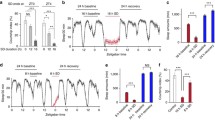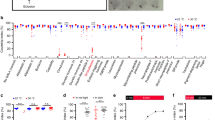Abstract
Some semelparous organisms in nature mate as many times as they can in a single reproductive episode before death, while most iteroparous species including humans avoid such suicidal reproductive behavior. Animals naturally pursue more sex and the possible fatal consequence of excessive sex must be orchestrated by negative feedback signals in iteroparous species, yet very little is known about the regulatory mechanisms. Here we used Drosophila male sexual behavior as a model system to study how excessive sex may kill males and how the nervous system reacts to prevent death by sex. We found that continuous sexual activity by activating the fruitless-expressing neurons induced a fixed multi-step behavioral pattern ending with male death. We further found negative feedback in the fly brain to prevent suicidal sexual behavior by expression changes of the neurotransmitters acetylcholine and gamma-aminobutyric acid, and neuropeptide F. These findings are crucial to understand the molecular underpinnings of how different organisms choose reproductive strategies and balance reproduction and survival.





Similar content being viewed by others
References
Rodriguez-Manzo G. Glutamatergic transmission is involved in the long lasting sexual inhibition of sexually exhausted male rats. Pharmacol Biochem Behav 2015, 131: 64–70.
Zhang SX, Rogulja D, Crickmore MA. Dopaminergic circuitry underlying mating drive. Neuron 2016, 91: 168–181.
Phoenix CH, Chambers KC. Old age and sexual exhaustion in male rhesus macaques. Physiol Behav 1988, 44: 157–163.
Fisher DO, Dickman CR, Jones ME, Blomberg SP. Sperm competition drives the evolution of suicidal reproduction in mammals. Proc Natl Acad Sci U S A 2013, 110: 17910.
Burtis KC, Baker BS. Drosophila doublesex gene controls somatic sexual differentiation by producing alternatively spliced mRNAs encoding related sex-specific polypeptides. Cell 1989, 56: 997–1010.
Ryner LC, Goodwin SF, Castrillon DH, Anand A, Villella A, Baker BS, et al. Control of male sexual behavior and sexual orientation in Drosophila by the fruitless gene. Cell 1996, 87: 1079–1089.
Ito H, Fujitani K, Usui K, Shimizu-Nishikawa K, Tanaka S, Yamamoto D. Sexual orientation in Drosophila is altered by the satori mutation in the sex-determination gene fruitless that encodes a zinc finger protein with a BTB domain. Proc Natl Acad Sci U S A 1996, 93: 9687–9692.
Demir E, Dickson BJ. Fruitless splicing specifies male courtship behavior in Drosophila. Cell 2005, 121: 785–794.
Manoli DS, Foss M, Villella A, Taylor BJ, Hall JC, Baker BS. Male-specific fruitless specifies the neural substrates of Drosophila courtship behaviour. Nature 2005, 436: 395–400.
Stockinger P, Kvitsiani D, Rotkopf S, Tirian L, Dickson BJ. Neural circuitry that governs Drosophila male courtship behavior. Cell 2005, 121: 795–807.
Cachero S, Ostrovsky AD, Yu JY, Dickson BJ, Jefferis GS. Sexual dimorphism in the fly brain. Curr Biol 2010, 20: 1589–1601.
Yu JY, Kanai MI, Demir E, Jefferis GS, Dickson BJ. Cellular organization of the neural circuit that drives Drosophila courtship behavior. Curr Biol 2010, 20: 1602–1614.
Inagaki HK, Jung Y, Hoopfer ED, Wong AM, Mishra N, Lin JY, et al. Optogenetic control of Drosophila using a red-shifted channelrhodopsin reveals experience-dependent influences on courtship. Nat Methods 2014, 11: 325–332.
Clowney EJ, Iguchi S, Bussell JJ, Scheer E, Ruta V. Multimodal chemosensory circuits controlling male courtship in Drosophila. Neuron 2015, 87: 1036–1049.
Kallman BR, Kim H, Scott K. Excitation and inhibition onto central courtship neurons biases Drosophila mate choice. Elife 2015, 4: e11188.
Chen D, Sitaraman D, Chen N, Jin X, Han C, Chen J, et al. Genetic and neuronal mechanisms governing the sex-specific interaction between sleep and sexual behaviors in Drosophila. Nat Commun 2017, 8: 154.
Pan Y, Meissner GW, Baker BS. Joint control of Drosophila male courtship behavior by motion cues and activation of male-specific P1 neurons. Proc Natl Acad Sci U S A 2012, 109: 10065–10070.
Wu S, Guo C, Zhao H, Sun M, Chen J, Han C, et al. Drosulfakinin signaling in fruitless circuitry antagonizes P1 neurons to regulate sexual arousal in Drosophila. Nat Commun 2019, 10: 4770.
Kimura K, Hachiya T, Koganezawa M, Tazawa T, Yamamoto D. Fruitless and doublesex coordinate to generate male-specific neurons that can initiate courtship. Neuron 2008, 59: 759–769.
Ho MS. A shared neural node for multiple innate behaviors in Drosophila. Neurosci Bull 2018, 34: 1103–1104.
Zhang SX, Miner LE, Boutros CL, Rogulja D, Crickmore MA. Motivation, perception, and chance converge to make a binary decision. Neuron 2018, 99: 376–388.e376.
Zhang SX, Rogulja D, Crickmore MA. Recurrent circuitry sustains Drosophila courtship drive while priming itself for satiety. Curr Biol 2019, 29: 3216–3228.e3219.
Harvanek ZM, Lyu Y, Gendron CM, Johnson JC, Kondo S, Promislow DEL, et al. Perceptive costs of reproduction drive ageing and physiology in male Drosophila. Nat Ecol Evol 2017, 1: 152.
Flintham EO, Yoshida T, Smith S, Pavlou HJ, Goodwin SF, Carazo P, et al. Interactions between the sexual identity of the nervous system and the social environment mediate lifespan in Drosophila melanogaster. Proc Biol Sci 2018, 285: 20181450.
Guo C, Pan Y, Gong Z. Recent advances in the genetic dissection of neural circuits in Drosophila. Neurosci Bull 2019, 35: 1058–1072.
Pan Y, Robinett CC, Baker BS. Turning males on: activation of male courtship behavior in Drosophila melanogaster. PLoS One 2011, 6: e21144.
Pan Y, Baker BS. Genetic identification and separation of innate and experience-dependent courtship behaviors in Drosophila. Cell 2014, 156: 236–248.
Hamada FN, Rosenzweig M, Kang K, Pulver SR, Ghezzi A, Jegla TJ, et al. An internal thermal sensor controlling temperature preference in Drosophila. Nature 2008, 454: 217–220.
Klapoetke NC, Murata Y, Kim SS, Pulver SR, Birdsey-Benson A, Cho YK, et al. Independent optical excitation of distinct neural populations. Nat Methods 2014, 11: 338–346.
Meissner GW, Luo SD, Dias BG, Texada MJ, Baker BS. Sex-specific regulation of Lgr3 in Drosophila neurons. Proc Natl Acad Sci U S A 2016, 113: E1256–1265.
Jenett A, Rubin GM, Ngo TT, Shepherd D, Murphy C, Dionne H, et al. A GAL4-driver line resource for Drosophila neurobiology. Cell Rep 2012, 2: 991–1001.
Ni JQ, Liu LP, Binari R, Hardy R, Shim HS, Cavallaro A, et al. A Drosophila resource of transgenic RNAi lines for neurogenetics. Genetics 2009, 182: 1089–1100.
Shohat-Ophir G, Kaun KR, Azanchi R, Mohammed H, Heberlein U. Sexual deprivation increases ethanol intake in Drosophila. Science 2012, 335: 1351–1355.
Zer-Krispil S, Zak H, Shao L, Ben-Shaanan S, Tordjman L, Bentzur A, et al. Ejaculation induced by the activation of Crz neurons is rewarding to Drosophila Males. Curr Biol 2018, 28: 1445–1452 e1443.
Tayler TD, Pacheco DA, Hergarden AC, Murthy M, Anderson DJ. A neuropeptide circuit that coordinates sperm transfer and copulation duration in Drosophila. Proc Natl Acad Sci U S A 2012, 109: 20697–20702.
Liu WW, Ganguly A, Huang J, Wang YJ, Ni JFD, Gurav AS, et al. Neuropeptide F regulates courtship in Drosophila through a male-specific neuronal circuit. Elife 2019, 8: 29.
Zhang W, Guo C, Chen D, Peng Q, Pan Y. Hierarchical control of Drosophila sleep, courtship, and feeding behaviors by male-specific P1 neurons. Neurosci Bull 2018, 34:1105–1110.
Acknowledgements
We thank the Tsinghua Fly Center and Bloomington Stock Center for the fly stocks. This work was supported by grants from the National Key R&D Program of China (2019YFA0802400), the National Natural Science Foundation of China (31970943, 31622028, and 31700920), and the Jiangsu Innovation and Entrepreneurship Team Program.
Author information
Authors and Affiliations
Corresponding author
Ethics declarations
Conflict of interest
All authors claim that there are no conflicts of interest.
Electronic supplementary material
Below is the link to the electronic supplementary material.
Rights and permissions
About this article
Cite this article
Gao, C., Guo, C., Peng, Q. et al. Sex and Death: Identification of Feedback Neuromodulation Balancing Reproduction and Survival. Neurosci. Bull. 36, 1429–1440 (2020). https://doi.org/10.1007/s12264-020-00604-5
Received:
Accepted:
Published:
Issue Date:
DOI: https://doi.org/10.1007/s12264-020-00604-5




